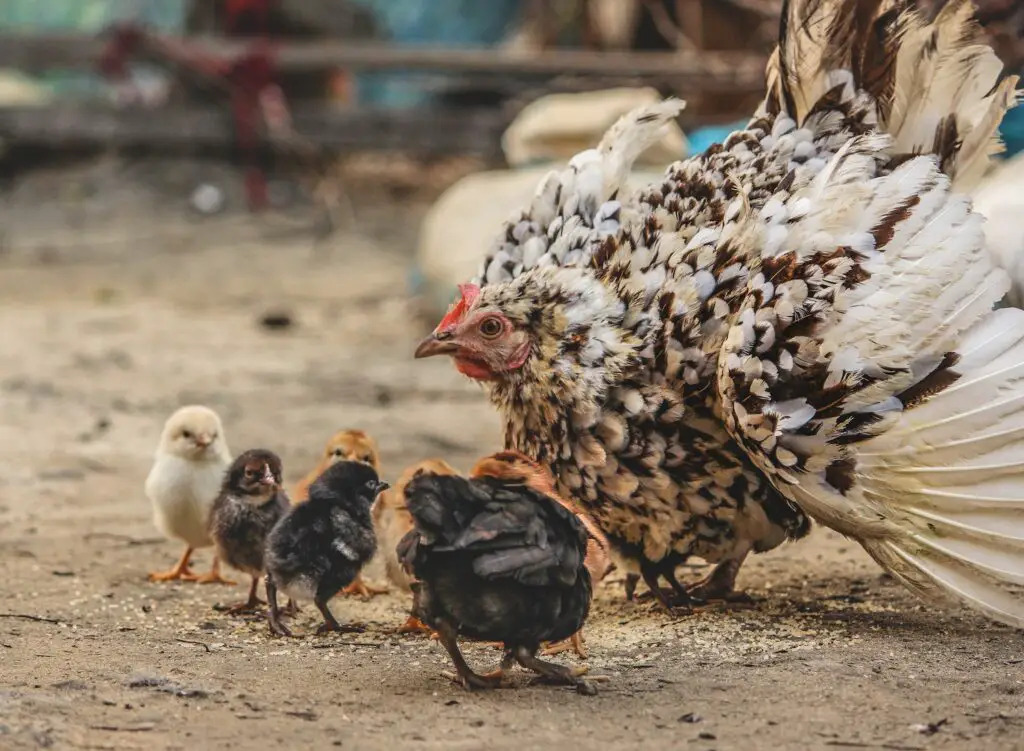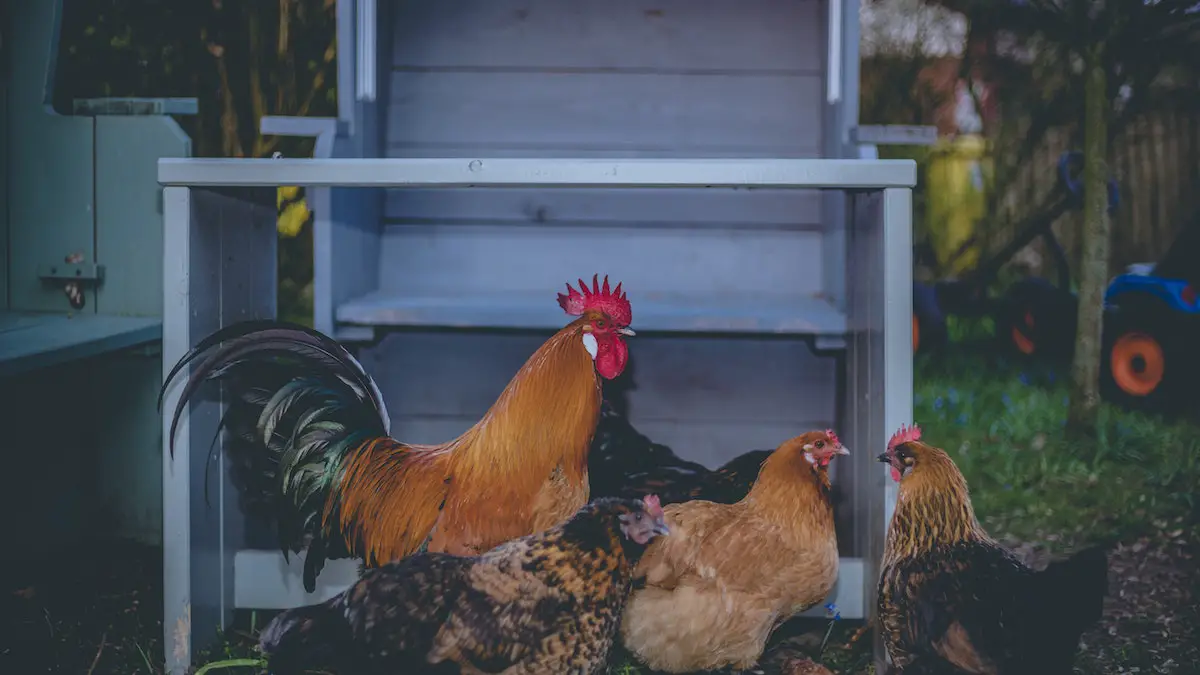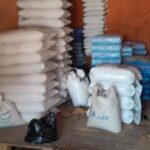Some links on this page may contain affiliate links which means that, if you choose to make a purchase using the link, Agricfy.com may earn a small commission at no extra cost to you. For more information, go to our Affiliate Disclosure Page!
Do you dislike seeing expensive chicken feed wasted? Do not be concerned. We’ve got you covered.
- Overview: Ways To Reduce Chicken Feed Wastes
- Why Do Chickens Waste Feed?
- How To Reduce Chicken Feed Waste
In this article, we provide you with the top ten brilliant methods on how to reduce chicken feed waste.
These innovative techniques can provide a sustainable and cost-effective approach to poultry feeding by not only saving you money but also keeping your feathery friends contentedly pecking away!
However, these solutions do more than just save you money; they create a balanced ecology inside your coop.
By using these techniques, you can save money while simultaneously fostering an environment that is conducive to the well-being of your beloved hens.
Not only do they continue to eat healthily, but they also continuously engage in activities and smile.
In addition to being good for your pocketbook, this dedication to effectiveness and well-being offers a sustainable approach to care for your feathery friends.
Believe me when I say that you’ll have both content chickens and a content wallet if you have these tactics up your sleeve.
Overview: Ways To Reduce Chicken Feed Wastes
Wasted chicken feed can cost you more than you’re prepared to charge for leftovers. Therefore, minimizing waste is crucial whether you intend to or are already raising hens in your garden.
By minimizing or eliminating feed waste, your choice of chicken feeder will enable you to save money on feed.
Although commercial chicken feeders are made to keep feed from falling to the ground or being consumed by vermin, they are not always reliable.
Sometimes a small adjustment may be necessary. Other times, it could be necessary to create a feeder for chickens that is completely different from the norm.
The situation will determine the best feeder to use, whether it is custom-made or store-bought. Weather and animals trying to steal food from the chickens are the two most frequent causes of wasted chicken feed. Our chickens are just sloppy eaters!
Fortunately, this issue may be solved in several ways, each of which is intended to deal with the numerous reasons why chicken feed waste occurs. Therefore, you should choose a feeder that best fits your circumstances.
The availability of materials and how you will maintain the overall structure are other considerations to think about.
The good news is that we came upon the assorted smart fixes described below. Whichever one you think will work best for your chickens, please let us know.
i. Chicken Treadle Feeder

The feeds are shielded by a chicken treadle feeder from both unwarranted weather exposure and animal predators. Preventing pests like rats, mice, and birds from contaminating the chicken feed, helps to keep it clean, dry, and safe. But when your chickens are starving, it makes it simple for them to get to their food.
The enjoyable part is explaining how it works to your chooks. Do not be concerned; they are intelligent and quick learners. Only when a chicken steps on a treadle does feed dispense, there is minimal food waste. Its main purpose is to grant poultry with restricted access to food.
ii. Hanging Chicken Feeder With Catch Box

Pests like mice, rats, and even snakes might be drawn in by a chicken feeder that is placed on the ground. The health of your chicken may suffer since the pests will have an easier time accessing the food.
The feed can very readily drop into the ground, luring additional pests. Installing a catch box will stop these things from happening. A container that is mounted on poles above ground is called a catch box.
You should store the chicken feed in a container so that pests have a difficult time accessing it. The feeder is also simple to fill and easy for your chickens to access thanks to the container’s open top and sides.
Although the mesh’s openings are small enough for animals to avoid them yet large enough for falling feed to fit through. In this manner, you can refill the poultry feeder with grain.
iii. Mess-Free Chicken Feeder

Another method to stop your birds from strewing food everywhere is this bucket-and-PVC-elbow chicken feeder.
They exhibit their cunning tendencies by curiously sticking their heads into the pipes and deftly gaining access to the feeds. Anything they can’t quite chew on falls back gently into the pail waiting below.
The simplicity of moving this system from one location to another contributes to its convenience.
iv. Cost-effective PVC Chicken Feeder

This one stops the feeds from leaking and from becoming contaminated. Additionally, it is simple to refill and won’t be knocked over by animals.
Once more, the simplicity and effectiveness of the refilling procedure also make the otherwise difficult chore of maintaining and guaranteeing the proper operation of your feeding system simple, making it essentially a painless endeavor.
This convenient function not only helps to increase the overall dependability of the feeding system by saving you important time and work, but it also benefits the user.
v. Goat-Proof Chicken Feeder Solution

This modified poultry feeder lives up to its name and is a great option, especially if you have other pets or wildlife in your yard.
Because of its clever design, the apertures may easily fit your chickens while efficiently keeping larger animals from getting to the food.
In essence, it offers a wise and useful option for preserving the nutritional value of your poultry in a setting with multiple animals.
Why Do Chickens Waste Feed?
Let’s examine the reasons why your flock could partake in this stressful and wasteful pastime before we get started.
Food is not intentionally wasted by chickens. They are designed to peck, scratch, and forage for food. They start by eating what appears best. Then they devour everything else they come upon that looks appetizing.
Additionally, food frequently spills everywhere because of the claw-scratching activity.
So, chickens don’t intend to waste food; it just happens as a result of how they naturally search for food. I’ll assure you that it’s not personal.
Additionally, opportunistic animals seeking to take your chickens’ feed and specific weather conditions can contribute to this issue or make it worse.
So let’s cooperate with our chickens’ natural feeding urges rather than opposing them to conserve some chicken feed.
How To Reduce Chicken Feed Waste

Chickens are known to eat in an untidy manner. Chickens naturally scratch at the ground in search of food as a means of survival.
Even if the feed is neatly hung in a feeding container, they will make an effort to scratch at it, squandering some of it and scattering it all over the ground.
You will undoubtedly benefit much from the ten tried-and-true strategies I’ll outline in this post for reducing chicken feed waste.
In that case, let’s begin.
1. Don’t Mix Chicken Feed with Treats
Chickens are comparable to kids (and many adults). When given the option of eating their vegetables or a reward, they will pick the treat. They would become satisfied after the treat and refuse to eat their vegetables.
Don’t combine anything else with the basic feed you give your hens. Feed them this first before giving them any layer pellets. This feed has the precise ratio of nutrients that your flock requires.
It is acceptable to give them snacks once they have finished eating their regular diet. Just watch that their treats don’t account for more than 10% of their daily calories.
2. Ration the Chicken Feed
Each chicken should consume around 1/4 lb of chicken feed (layers pellets or crumbles) per day.
This may differ significantly depending on the size, breed, type of feed, and whether you let your hens roam free.
Let’s imagine you have 6 chickens that are fully matured. The amount of feed that your flock would eat each day would be 1.3 pounds, or 9 pounds each week. You’d get five to six weeks out of the 50-pound bag of feed.
Let’s also pretend you have a full twelve chickens because, you know, chicken math. Now, your chickens will use roughly 18 pounds of feed each week. Therefore, every two to three weeks, you will require a fresh 50-pound bag of feed.
Since it takes a lot of work and expertise to get it right, this advice can demand more hands-on work than the others. However, if you’re feeling energetic, you should be able to use a bag of feed with little wastage.
Please be aware that every flock has different feeding needs. For example, feeding a flock of broilers the same quantity of feed as a flock of layers or a flock of chicks the same amount of feed as a flock of hens is not appropriate.
If you want to implement this advice, be sure to check up on your hens to see if there is enough food.
However, the only drawback to this advice is that certain chickens at the bottom of the pecking order can occasionally run out of feed.
I know that with 12 hens, I should fill it up every 5-7 days, depending on the weather or whether the chickens are molting.
If I forget to replenish the bucket by 15 minutes, I know the chickens will be alright because they also have a pasture to forage in.
By doing so, I can restrict the feed, reduce waste, and avoid straining my back by attempting to make everything too complicated.
Signs You Need to Ration Your Chickens’ Feed (Overfeeding)
– Each of your birds consumes more than 1/4 pound of feed per day.
– At night, a lot of feed is left on the ground.
– You have overweight chickens.
– Change in the laying habits.
– Egg quality has changed.
– Chickens are more sluggish.
3. Put Food Away Every Evening
If you decide to let your hens consume feed all day, be careful to bring it inside at night.
Inviting nocturnal grazers to enter your chicken coop by leaving it out all night is irresponsible for the chicken, but also for your eggs!
Don’t let the odor of leftover chicken feed tempt nocturnal predators to break into the coop and harm your chickens.
Defend against predators that prowl the night for chickens, including raccoons, opossums, foxes, coyotes, owls, mice, rats, bears, and snakes.
Wild bird feeders and leftover cat and dog food are additional food sources that will draw evening chicken predators.
4. Position The Chicken Feed Higher
It’s normal for chickens to peck and scratch for food, including food that is in a feeder. Raising the feeders a few inches will assist in preventing them from clawing their food.
This will prevent them from dispersing the seed all over the place.
Chickens naturally graze on food, so I like to make it a point to distribute some daily treats, like scratch, around the field or chicken coop to sate their drive to peck and scratch.
5. Change the Type of Chicken Feed
Mash, crumbles, and pellets are the three most popular types of chicken feed.
It is customary to switch newborn chicks from chick mash or crumbles to layers of crumbles or pellets as soon as they are close to 16 weeks old or ready to lay eggs.
I’ve discovered that if I move my chickens to pellets, they leave a lot less mess and produce a lot less waste.
6. Ferment the Chicken Feed
If you ferment chicken feed, there is less feed waste. To ferment chicken feed, soak and mix chicken grains in distilled water for three days, then drain and feed to your flock.
They will use less feed since it allows your chickens to access up to 50% more nutrients.
Also, lacto-fermentation is the kind of fermentation you should submit your feed to. This kind of fermentation traps the advantageous bacteria (lactobacillus) that are naturally present in the environment, allowing them to interact with the feed and break down the sugar and starch to produce lactic acid bacteria, which in turn results in the production of organic probiotics.
Here’s a quick and safe way to accomplish it:
– Choose any feed you like, and fill a glass jar to the top.
– Add enough dechlorinated water to cover your feed by a few inches.
– For about three to four days, cover and leave your glass jar outside.
– Ensure that it is exposed to room temperature.
This is a condensed list of directions. Therefore, ensure that you read up on it more thoroughly than this, and feel free to experiment with it after you’re comfortable with fermented chicken feed.
Beyond the basics, I haven’t done anything with fermented feed. But now that I’ve mastered dry feed and feed-free options, I don’t rely on this as my major strategy for lowering feed waste.
Benefits of Fermenting Chicken Feed
These are some of the advantages associated with fermenting your chicken feed:
– Less waste from feed
– More probiotics
– More eggs
– Tastier eggs
– Stronger eggshells
– Increased nutrients
– Decreased feces
– Improved digestion
– Lower feed costs
– Healthier chickens
7. Sprout Chicken Grains
Another method to cut down on wasted chicken feed is to sprout grains. When I give sprouted grains to my chickens, they go completely crazy.
Not a single sprout goes to waste. They’d assume I’m giving them candy, to be honest.
Up to 50% more nutrients are found in sprouted grains. Once the grain sprouts, these nutrients are accessible to your chickens.
Additional Benefits of Sprouting Chicken Grains
The increased ingredients in sprouted grains include:
– Folate
– Magnesium
– Vitamin C
– Zinc
– Iron
– Protein
8. Serve Chicken Fodder
How do sprouts and fodder differ from one another?
“Sprouts and fodder are both made from grains. When you harvest them, they are known as sprouts if they are between 1/2″ and 2″, and fodder is when they are longer than 2”.
It is ideal to feed your chickens just pieces of hay that are no longer than 4″ inches long. Any longer than this raises the likelihood that it will produce an impaired crop
Do Chickens Benefit More from Sprouted Grains?
Serving fodder to your chickens is a great method to ensure that they have access to greens all year round. Like grains, my chickens adore fodder, and they typically eat every last bit of it.
You’ll notice that because fodder has nutrients, your flock won’t need to consume as much feed.
Top Chicken Grains Used for Fodder
– Wheat barley
– Alfalfa oats
– Soybeans & mung beans
– Millet sunflower seeds
– Sorghum buckwheat
– Grain rye peas
– Lentils corn
9. Keep Feed Storage Containers Secure
Maintain secure storage for your chicken feed to prevent access by animals and predators.
Utilizing the proper container type to store your chicken feed is another aspect of securing your feed storage containers.
Raccoons can take the lid off a basic garbage can and readily access gates with latches. For a late-night feast, cats, dogs, rats, mice, opossums, and raccoons are all capable of readily chewing through chicken feed bags.
Which Method Is Best for Securing Chicken Feed?
Use Metal Can For Chicken Feed
The majority of animals and predators won’t be able to access your chicken feed if you use metal trash cans with a 2-step lid on them.
Multiple steps are necessary to open a 2-step lock. These have been very effective for me in keeping rodents, raccoons, and opossums away.
I’ve personally seen raccoons, opossums, rats, and mice at night in my area, but they haven’t been able to get into my metal trash cans because they have a 2-step cover on them.
10. Keep Chickens Entertained
Chickens who are bored often get into inappropriate situations. This involves squandering, strewing, and spilling their regular chicken feed.
Chickens need to be able to peck and scratch for food (at least occasionally) and to roam free in their environment. If they are not introduced to new things, they may become quickly bored.
Best Ways to Entertain Bored Chickens
Here are some of the best ways to keep your bored chickens entertained:
– Dish out a few mealworms for them to devour.
– Install a brand-new roosting bar in the coop or chicken run.
– Give them your old jack-o-lantern before throwing it away.
– Provide them with some sprouted grains or feed.
– Allow them to roam freely in the open while under supervision.
– Get along with them.
– Hang some produce on a hook for them to consume.
– Make a fresh space for them to take dust baths.
– Disperse some crickets for them to catch.
Conclusion
Our chickens may enjoy eating a lot, but they can also be quite wasteful. However, they don’t have to be, and we don’t have to keep tidying up after them.
Many strategies can effectively combat feed waste. Simply choose the option that best suits your needs. It may be simple to replace a poor feeder or withhold feed to reduce feed waste.
But by all means, use the other solutions described above if you’re still having trouble with this costly issue after putting these two into practice. We promise that these techniques will be very successful in reducing the issue.
Additionally, you should check to see if any of your hens have any physical conditions like sour crop, crop impaction, or gapeworm that could be the cause of any wasted or neglected feed.
I hope you found this article helpful. Do share your thoughts with us by filling out the “Leave A Reply” form found below.







